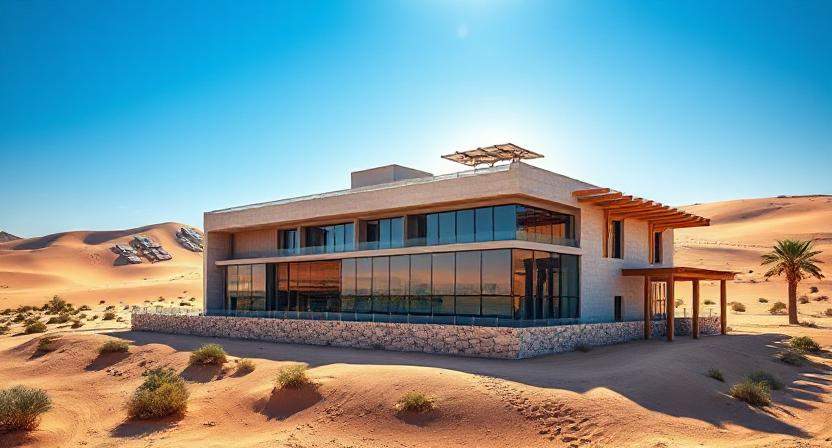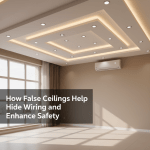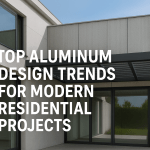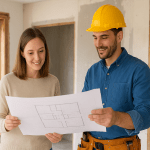
Building in the United Arab Emirates (UAE) presents unique challenges due to the region’s extreme desert climate. With iconic architecture and rapid development across the Emirates, selecting durable and climate-resilient building materials is crucial. The intense heat, coastal humidity, and frequent sandstorms demand materials that can withstand harsh conditions while promoting energy efficiency and sustainability.
In this blog, we explore the best building materials suited for the UAE’s climate and why they matter in creating energy-efficient, sustainable, and resilient structures.
1. Insulated Concrete Forms (ICFs)
Insulated Concrete Forms combine reinforced concrete with insulation, offering superior thermal resistance. ICFs help regulate indoor temperatures, reducing reliance on air conditioning systems – a significant benefit in the UAE, where cooling accounts for a major portion of energy use.
Benefits:
- High thermal insulation
- Soundproofing
- Fire and pest resistance
- Durable against heat and moisture
2. Reflective Roofing Materials
Cool roofs made from reflective materials or light-colored coatings can deflect more sunlight and absorb less heat than traditional roofing. Materials like reflective tiles, metal roofing with reflective coatings, or solar-reflective membranes are ideal for reducing indoor temperatures.
Benefits:
- Reduces cooling costs
- Enhances roof lifespan
- Minimizes heat island effect in urban areas
3. Autoclaved Aerated Concrete (AAC) Blocks
AAC blocks are lightweight, thermally efficient, and easy to work with. They offer excellent insulation properties, making them ideal for reducing heat transfer and improving energy performance in buildings.
Benefits:
- High thermal insulation
- Fire resistance
- Lightweight and easy to install
- Environmentally friendly
4. High-Performance Glass and Glazing
Windows are a critical component in UAE buildings, often facing intense solar radiation. Low-emissivity (Low-E) glass, double glazing, or triple glazing systems with UV filters reduce heat gain while allowing natural light to enter. Tinted and coated glass options are also widely used.
Benefits:
- Reduces solar heat gain
- Enhances indoor comfort
- Improves energy efficiency
- Protects interiors from UV damage
5. Fiber Cement Board
Fiber cement board is highly durable and can withstand the UAE’s high humidity and sand exposure. Used for cladding, partitions, and ceilings, it combines cement with cellulose fibers, offering strength and weather resistance.
Benefits:
- Moisture and mold resistant
- Fireproof
- Long lifespan with low maintenance
6. Stone Cladding
Natural stone is popular in luxury villas and commercial projects across the UAE. Materials like limestone, granite, and travertine are used for façades, offering a timeless aesthetic while providing natural insulation.
Benefits:
- Withstands heat and sand erosion
- Adds thermal mass
- Low maintenance and long-lasting appeal
7. Sustainable Wood Alternatives
Traditional wood tends to degrade in extreme heat and humidity, but modern engineered wood products or composites, such as WPC (wood-plastic composite), offer the look of wood with enhanced durability. These are great for outdoor decks, cladding, and pergolas.
Benefits:
- Weather and termite resistant
- Eco-friendly options available
- Minimal upkeep required
8. Solar Panels and Energy-Efficient Systems
While not a material in the traditional sense, integrating solar technologies and energy-efficient HVAC systems into building design is increasingly critical. Given the UAE’s abundant sunlight, solar panels can significantly reduce reliance on grid electricity.
Benefits:
- Reduces carbon footprint
- Long-term energy savings
- Aligns with UAE’s sustainability goals
Conclusion
Selecting the right building materials in the UAE is more than a matter of aesthetics or cost—it’s a strategic choice that impacts energy consumption, durability, and environmental performance. From thermally insulated concrete and reflective roofing to smart glass and solar energy, modern construction in the UAE must balance performance with sustainability.
As urban development accelerates across Dubai, Abu Dhabi, and other emirates, forward-thinking builders and developers are increasingly choosing building materials that support long-term climate resilience. Investing in the right building materials today ensures comfort, cost-efficiency, and compliance with future green building standards.
Stay tuned to our blog for more insights on sustainable construction and the future of architecture in the Middle East.
Contact us for more details







